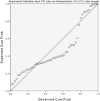Random spot urine protein/creatinine ratio: a reliable method for monitoring lupus nephritis?
- PMID: 26069827
- PMCID: PMC4438366
- DOI: 10.1093/ckj/sft118
Random spot urine protein/creatinine ratio: a reliable method for monitoring lupus nephritis?
Abstract
Background: Lupus nephritis (LN) is a common and severe manifestation of systemic lupus erythematosus (SLE) that can lead to end-stage renal disease. According to the Kidney Disease Outcomes Global Improving clinical Guidelines for Glomerulonephritis, spot urine protein/creatinine (P/C) ratio should be used for monitoring LN. However, some reports write that the random spot urine P/C ratio is unreliable in monitoring proteinuria in SLE glomerulonephritis patients. The aim of this study was to evaluate the agreement of these two assay methods.
Methods: The prospective observational study was performed. Fifty-three paired (total 106) spot and 24-h urine collections were evaluated.
Statistical analysis: SPSS 20.0.
Results: Paired samples t-test did not reveal significant differences between the two-paired assay methods (spot P/C ratio versus 24-h proteinuria and 24-h P/C ratio) and a statistically significant correlation was observed between them: Pearson's coefficient of 0.847 (P < 0.001) and 0.863 (P < 0.001), respectively. However, after stratifying by degrees of proteinuria, a poor correlation was found in the range of <500 mg/day and only 26.6% of 24-h P/C ratio was explained by the spot P/C ratio. Adding to this, for proteinuria range between 500 and 1000 mg/day, there was no correlation (Pearson's -0.098; P > 0.05). In fact, only 1% of 24-h measurements could be explained by the spot P/C ratio.
Conclusions: Our study demonstrated a good correlation between 24-h proteinuria and random P/C ratio among patients with LN. However, this correlation was poor for proteinuria under 500 mg/day and did not exist in a range between 500 and 1000 mg/day. This finding is of greater importance because this range is quite common in patients with LN remission. Until further clarification, to the best of our knowledge, we maintain reluctant to completely substitute the 24-h collection by the P/C ratio especially when a renal flare is suspected, or before any change in therapy.
Keywords: glomerulonephritis; lupus nephritis; proteinuria.
Figures
Similar articles
-
Spot urine protein/creatinine ratios are unreliable estimates of 24 h proteinuria in most systemic lupus erythematosus nephritis flares.Kidney Int. 2007 Oct;72(7):865-70. doi: 10.1038/sj.ki.5002421. Epub 2007 Jul 25. Kidney Int. 2007. PMID: 17653137
-
Random spot urine protein/creatinine ratio is unreliable for estimating 24-hour proteinuria in individual systemic lupus erythematosus nephritis patients.Nephron Clin Pract. 2009;113(3):c177-82. doi: 10.1159/000232599. Epub 2009 Aug 12. Nephron Clin Pract. 2009. PMID: 19672116 Free PMC article.
-
Spot urine protein/creatinine ratio is unreliable estimate of 24 h proteinuria in lupus nephritis when the histological scores of activity index are higher.Lupus. 2015 Aug;24(9):943-7. doi: 10.1177/0961203315570688. Epub 2015 Feb 9. Lupus. 2015. PMID: 25670710
-
Commentary on the Current Guidelines for the Diagnosis of Lupus Nephritis Flare.Curr Rheumatol Rep. 2019 Feb 27;21(4):12. doi: 10.1007/s11926-019-0809-x. Curr Rheumatol Rep. 2019. PMID: 30810824 Review.
-
Interferon-Inducible Protein 10 and Disease Activity in Systemic Lupus Erythematosus and Lupus Nephritis: A Systematic Review and Meta-Analysis.Int J Mol Sci. 2019 Oct 8;20(19):4954. doi: 10.3390/ijms20194954. Int J Mol Sci. 2019. PMID: 31597273 Free PMC article.
Cited by
-
Diagnostic efficacy and influence factors of urinary protein/creatinine ratio replacing 24-h urine protein as an evaluator of proteinuria in children.Int Urol Nephrol. 2022 Jun;54(6):1409-1416. doi: 10.1007/s11255-021-03021-3. Epub 2021 Oct 19. Int Urol Nephrol. 2022. PMID: 34668110
-
Precision medicine in systemic lupus erythematosus.Nat Rev Rheumatol. 2023 Jun;19(6):331-342. doi: 10.1038/s41584-023-00948-y. Epub 2023 Apr 11. Nat Rev Rheumatol. 2023. PMID: 37041269 Review.
-
Simplified Algorithm for Evaluation of Proteinuria in Clinical Practice: How should A Clinician Approach?Int J Prev Med. 2019 Mar 5;10:35. doi: 10.4103/ijpvm.IJPVM_557_18. eCollection 2019. Int J Prev Med. 2019. PMID: 30967921 Free PMC article.
-
Clinical and Immunological Biomarkers for Systemic Lupus Erythematosus.Biomolecules. 2021 Jun 22;11(7):928. doi: 10.3390/biom11070928. Biomolecules. 2021. PMID: 34206696 Free PMC article. Review.
References
-
- Al Arfaj AS, Khalil N. Clinical and immunological manifestations in 624 SLE patients in Saudi Arabia. Lupus. 2009;18:465–473. - PubMed
-
- Bastian HM, Roseman JM, McGwin G, Jr, et al. Systemic lupus erythematosus in three ethnic groups. XII. Risk factors for lupus nephritis after diagnosis. Lupus. 2002;11:152–160. - PubMed
-
- Seligman VA, Lum RF, Olson JL, et al. Demographic differences in the development of lupus nephritis: a retrospective analysis. Am J Med. 2002;112:726–729. - PubMed
-
- Rosner S, Ginzler EM, Diamond HS, et al. A multicenter study of outcome in systemic lupus erythematosus. II. Causes of death. Arthritis Rheum. 1982;25:612–617. - PubMed
-
- Adler M, Chambers S, Edwards C, et al. An assessment of renal failure in an SLE cohort with special reference to ethnicity, over a 25-year period. Rheumatology (Oxford) 2006;45:1144–1147. - PubMed
LinkOut - more resources
Full Text Sources
Other Literature Sources



